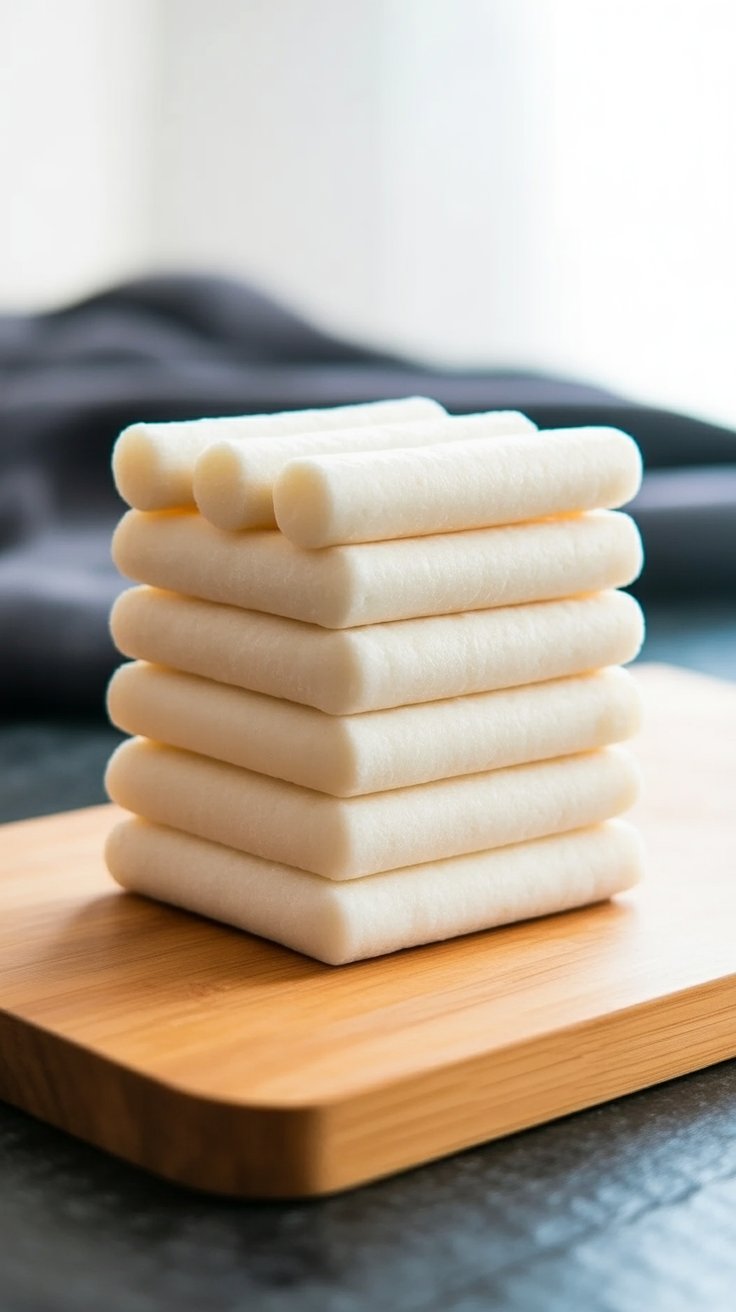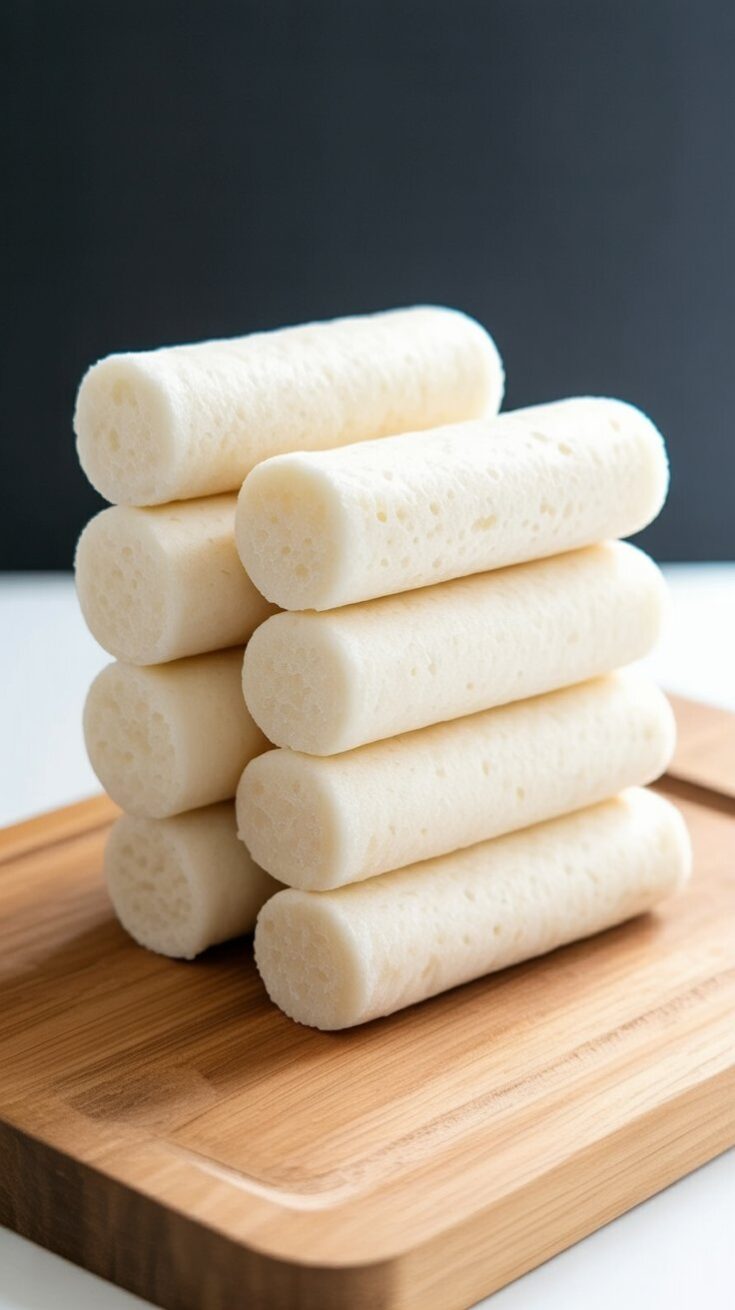Garaetteok holds a special place in my kitchen because it’s the base for two of my favorite comfort foods — tteokbokki (spicy rice cakes) and tteokguk (rice cake soup). When I was younger, I only had access to store-bought ones from my local Korean market. But once I moved to a place without one nearby, I realized how much I missed the chewy, bouncy texture of freshly made rice cakes.

That’s when I started making them at home. The first time was a bit messy, but once I got the hang of soaking rice overnight and working the dough while hot, I was hooked. Now, I actually prefer homemade garaetteok — it’s fresher, softer, and has that satisfying bite you just can’t get from the packaged ones.
Why I Love Making Garaetteok at Home
-
It connects me to tradition — homemade rice cakes feel special, especially during Korean New Year when I make tteokguk.
-
Freshness makes all the difference — the chewiness is unbeatable.
-
It’s surprisingly simple with just a few ingredients: rice flour, starch, salt, and hot water.
-
You can shape them differently depending on what dish you’re cooking — thick cylinders for stir-fries or thin ovals for soup.
Every time I make them, I’m reminded that some of the best dishes are made from the simplest things.
Making Your Own Rice Flour
If you’re lucky, your local Korean grocer might sell wet-milled rice flour in the freezer section — and that saves a ton of time. But when I can’t find it, I make it from scratch.
Here’s my routine:
-
I soak short-grain or medium-grain rice overnight. The soaking is key because it softens the grains and makes grinding easier.
-
After draining, I let it air dry for about an hour.
-
Then into the food processor it goes until it becomes a fine powder. A good scrape down in between helps it grind evenly.
-
I always sift the flour twice. It’s an extra step, but it makes the rice cakes smoother.
One tip: in hot weather, I soak the rice in the fridge so it doesn’t ferment. I learned that lesson after leaving a bowl out overnight once, only to wake up to a faint sour smell.
Key Ingredients You’ll Need
-
Rice Flour – Homemade or store-bought, made from short- or medium-grain rice.
-
Cornstarch – Helps with elasticity.
-
Salt – Just a pinch for flavor.
-
Boiling Water – The amount may vary depending on how wet or dry your flour is.
-
Sesame Oil – Keeps the dough from sticking and adds subtle aroma.
That’s it! No long shopping list, just pantry basics.
Microwave or Steamer – Two Cooking Methods
I’ve tried both, and honestly, I use whichever fits my mood (and how much time I have).
-
Microwave Method – Faster, but you have to watch carefully so the dough doesn’t overcook. It’s great for small batches or when I’m craving tteokbokki in a hurry.
-
Steamer Method – More traditional and forgiving. The dough cooks evenly, and I find it easier to knead afterward.
Whichever method you choose, the key step is kneading and pounding the dough while it’s hot. I always wear thick cotton gloves with food-safe gloves on top so I can handle it without burning my hands. Once kneaded, the dough becomes elastic and smooth, ready to be shaped.

Tips That Make the Process Easier
-
Add boiling water a little at a time. It’s easier to fix slightly dry dough than soupy dough.
-
Knead while hot. It feels awkward at first, but the texture won’t be right if you let it cool.
-
For shaping, I like to rub a little sesame oil on my hands — it stops sticking and gives the rice cakes a nice shine.
-
If you’re rolling them into long cylinders, let them cool slightly before cutting — they hold their shape better that way.
Preparing for Tteokbokki
When I’m making garaetteok for tteokbokki, I shape the dough into thinner cylinders, about the size of my little finger. Then I cut them into short sticks, each about 2 inches long. Once they cool, they’re perfect for tossing into that fiery red gochujang sauce.
Sometimes, I’ll make a big batch and freeze them in portions. That way, a quick tteokbokki fix is always within reach.
Preparing for Tteokguk
For rice cake soup, the process is slightly different. I roll the dough into thicker logs, chill them a bit, then slice them diagonally into thin ovals. Those slices are what you see floating in the clear, savory broth during Lunar New Year celebrations.
It’s a small ritual for me — making and slicing the garaetteok, then simmering the soup while reflecting on the year ahead.
Storage and Freshness Tips
-
Freshly made garaetteok is best eaten the same day — soft, chewy, and tender.
-
If you need to store them, slice them first, then freeze in a zip-top bag. They keep for about a month.
-
To use frozen rice cakes, soak them in warm water for a few minutes before cooking. They’ll bounce back to life beautifully.
Creative Ways to Use Garaetteok
Beyond the classics like tteokbokki and tteokguk, I’ve had fun experimenting:
-
Tteok-Kkochi – Grilled rice cake skewers brushed with a sweet-savory sauce.
-
Rose Tteokbokki – Creamy and spicy, a fusion twist.
-
Rabokki – A mix of ramen and rice cakes that’s pure comfort food.
-
Pan-Fried Garaetteok – Just seared in sesame oil until crispy on the outside and chewy inside.
Once you have a batch at home, you’ll find yourself reaching for it more often than you think.

FAQs
Can I use long-grain rice to make garaetteok?
No, it won’t give you the chewy texture you’re looking for. Stick with short- or medium-grain rice.
Do I need a food processor to make rice flour?
It helps a lot, but a high-powered blender can work too. Just make sure to sift well.
What if I can’t knead the dough while hot?
You can let it cool a bit, but don’t wait too long. The elasticity comes from kneading while it’s still warm.
Can I store homemade rice flour?
Yes, keep it in the freezer in a sealed bag for up to 3 months. Sift it again before using.
Garaetteok (Rice Cake Recipe)

Garaetteok, the classic Korean cylinder-shaped rice cake, is the star ingredient in two beloved dishes: tteokbokki (spicy stir-fried rice cakes) and tteokguk (New Year’s rice cake soup).
Ingredients
- 2 cups wet-milled rice flour (from short or medium-grain rice, about 300g)
- 1 tablespoon cornstarch
- 1 teaspoon fine salt
- ¾ cup boiling water, divided into three ¼-cup portions (microwave version)
- ⅔ cup boiling water (steamer version)
- ½ teaspoon sesame oil
Instructions
- Making Rice Flour (Optional):- Rinse short- or medium-grain rice thoroughly until the water runs clear, then soak overnight. Drain, air dry for about an hour, and grind finely in a food processor until you achieve a smooth flour. Sift well, returning any coarse bits to the grinder. This method yields around 4.5 cups of flour.
- Microwave Method:- In a microwave-safe bowl, mix rice flour with cornstarch, salt, and the first ¼ cup of boiling water. Stir until smooth, then add another ¼ cup water and stir again. Cover with plastic wrap (leave a vent) and microwave for 2 minutes. Stir in the last ¼ cup water, cover again, and microwave for 1½ minutes more. Carefully transfer the hot dough to a lined board, then knead and pound with a pestle for 5 minutes until elastic.
- Steamer Method:- Mix rice flour, cornstarch, salt, and ⅔ cup boiling water until smooth. Spread the dough onto a steamer lined with parchment or a tea towel, cover, and steam for 20 minutes on high heat. Transfer the hot dough to a lined surface, then knead and pound for 5 minutes until smooth and stretchy.
- Shaping for Tteokbokki:- Divide the dough into 5 pieces. Rub your hands with sesame oil and roll each piece into a long cylinder about 1–1.5 cm thick. Cut into 6 cm lengths (about finger-sized). These are ready for stir-fried tteokbokki.
- Shaping for Tteokguk:- Divide the dough into 2 larger pieces. Rub lightly with sesame oil, roll into thicker cylinders about 2–3 cm wide, and chill for 1 hour. Slice diagonally into thin ovals about 0.5 cm thick. These slices are perfect for rice cake soup.
Notes
- If you can’t find wet-milled rice flour, make your own at home with soaked short-grain rice. It gives a much better chew than dry flour.
- One batch makes roughly 450g (1 pound) of rice cake.
- Microwave times are based on a 1250W microwave—adjust slightly if yours is weaker.
- Cover your surface with a silicone mat or plastic wrap to prevent sticking while kneading and shaping.
Nutrition Information
Yield
4Serving Size
1Amount Per Serving Calories 302Total Fat 2gSaturated Fat 0gTrans Fat 0gUnsaturated Fat 1gCholesterol 0mgSodium 538mgCarbohydrates 65gFiber 2gSugar 0gProtein 5g
Easy Shrimp Recipes.com, occasionally offers nutritional information for recipes contained on this site. This information is provided as a courtesy and is an estimate only. This information comes from online calculators. Although allchickenrecipes.com attempts to provide accurate nutritional information, these figures are only estimates.
Final Thought
Making garaetteok from scratch is one of those kitchen projects that feels rewarding every single time. It takes a bit of patience, but the end result — chewy, fresh rice cakes that you can turn into countless dishes — is so worth it. Whether you’re preparing a traditional tteokguk for a holiday or whipping up a quick tteokbokki on a weeknight, homemade garaetteok adds that personal touch you just can’t get from a package.

